#coffeedreamland
Explore tagged Tumblr posts
Text
Baileys Iced Coffee
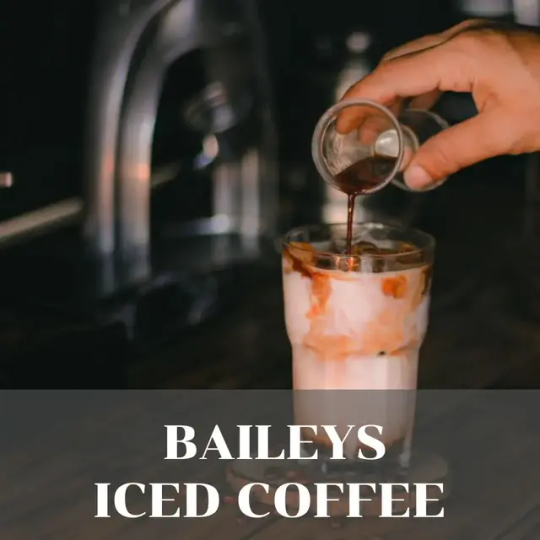
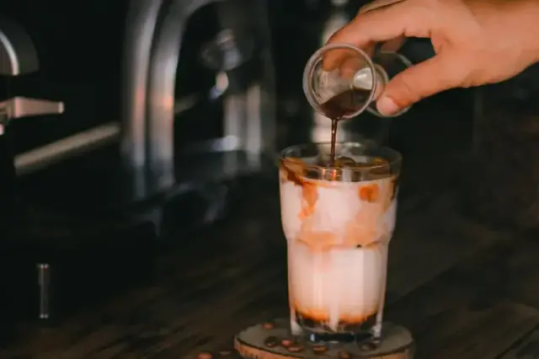
Baileys Iced Coffee Servings: 1 Ingredients For Baileys Iced Coffee 3 1/2 ounces Baileys Original Irish Cream 7 ounces of freshly brewed coffee Or 2 espresso shots if a strong coffee taste is preferred. Directions To Make Baileys Iced Coffee Brew coffee and allow it to cool Pour Baileys and coffee into a tall, ice-filled glass Topped with whipped cream, optional. Stir and enjoy! Would you like to see more Baileys recipe ideas? Do you prefer a classic Baileys iced coffee, or do you like to add other flavors? What are your favorite toppings for iced coffee? Whipped cream, caramel drizzle, or something else? If you'd like a mocktail version, what non-alcoholic substitute would you use for Baileys? Email Twitter Pinterest Facebook LinkedIn Reddit Keep In Touch If You Like My Articles. As much as I like to share my knowledge and skills with you, I love to hear from you. If you have any suggestions or comments, please click here. Also don't forget to subscribe to our quarterly newsletters if you like my blogs and like to keep in touch. Of course, read more blog posts I post now and then, such as "Cold Brew At Home". Read the full article
0 notes
Text
Unveiling the Mystery: Are Coffee Beans and Espresso Beans the Same?


Regular Coffee Beans and Espresso Beans Are The Same? Are coffee beans and espresso beans the same? Once upon a time in the aromatic realms of coffee, a question brewed in my mind: Are coffee beans and espresso beans the same? As I embarked on a journey through the vast expanse of coffee knowledge, I stumbled upon a rich knowledge of flavors, myths, and facts surrounding this caffeinated enigma. To dig into this mystery, I search for the essence of coffee, exploring its origins, processing methods, and the science behind the brew. The Origins of Coffee Beans: A Global Adventure Coffee, a beverage that has enchanted cultures across the world for centuries, begins its journey as a humble bean. Native to the lush regions of Ethiopia, coffee beans made their way to various corners of the globe, adapting to diverse climates and elevations. From the hills of Colombia to the highlands of Ethiopia, coffee plants have cultivated unique characteristics, resulting in a myriad of distinct flavors.To understand the distinction between coffee beans and espresso beans, we must first understand that coffee beans are the common ancestors of various coffee beverages, including espresso. Arabica and Robusta are the two primary species of coffee beans widely consumed today, each contributing its nuances to the world of coffee. Diverging Paths: Arabica and Robusta Beans Arabica beans, often heralded as the more refined and aromatic of the two, originate from high-altitude regions. Renowned for their aromatic flavors, Arabica beans boast a wide range of taste profiles, from fruity and floral to nutty and chocolaty. These beans are often associated with specialty coffee and are a favorite among those who appreciate a more intricate coffee experience.Robusta beans thrive at lower elevations and are celebrated for their bold, robust character. With a higher caffeine content and a stronger, more bitter flavor, Robusta beans add depth to many espresso blends. Espresso aficionados often appreciate the punchy and intense qualities that Robusta brings to the cup. The Espresso Mystery: A Distinct Brewing Method Now, let's talk about espresso. Contrary to popular belief, espresso is not a specific type of beans but rather a brewing method. The process involves forcing hot water through finely-ground coffee under high pressure, resulting in a concentrated and flavorful shot. This method has given rise to the misconception that there are "espresso beans." Espresso can be crafted from ANY coffee bean, but certain characteristics make some beans more suitable for this brewing style. Dark roasts, often associated with espresso, are preferred for their rich, caramelized flavors that can withstand the intensity of the brewing process. However, this doesn't mean that espresso beans are a distinct category. So…The truth is, there's no such thing as a special "espresso bean." Both regular coffee beans and espresso beans come from the same two bean families: Arabica and Robusta. The real secret lies in the roast. Think of roasting as giving the beans a makeover. Regular coffee beans get a quick tan, like a light or medium roast, for a bright, balanced flavor. But espresso beans? They get a full-on makeover, a dark roast that transforms them into rich, bold beauties. This dark roast unlocks more oils, intensifies the flavor, and reduces acidity, making the beans perfect for withstanding the high pressure of an espresso machine. Decoding the Roast Just how different are these roasts? Let's crunch some numbers:Roast Level: Regular coffee: Light-Medium, around 400°F; Espresso: Dark, around 460°F+ Oil Content: Regular coffee: 12-15%, Espresso: 18-22% Acidity: Regular coffee: More prominent, Espresso: Less prominentSee? That dark roast does pack a punch! Dispelling Myths with Facts According to a study by the International Coffee Organization, Arabica beans constitute approximately 60-70% of global coffee production, while Robusta makes up the remaining 30-40%. This data debunks the notion that there is a separate category of beans exclusively designated for espresso. Furthermore, a survey conducted by the National Coffee Association in 2023 found that 42% of coffee drinkers in the United States prefer Arabica coffee, appreciating its smoother and more nuanced flavors. On the other hand, 27% of respondents favored Robusta for its bolder taste and higher caffeine content. These statistics emphasize the diverse preferences among coffee enthusiasts, reinforcing the idea that the choice of coffee beans for espresso is subjective and based on individual taste preferences. Beyond the Roast: Brewing Techniques Take Center Stage But wait, there's more! The real difference isn't just in the beans, it's in how they're brewed as I explained above. Regular coffee beans get a leisurely steep in your French press, while espresso beans get forced through a tiny portafilter under intense pressure. This pressure creates that signature crema, the foamy goodness on top of your espresso shot. It's all about maximizing flavor extraction in a short amount of time. So, Can You Use Espresso Beans for Regular Coffee? Technically, yes. But be warned, you might not like the results. The dark roast makes espresso beans strong and intense, which can be overwhelming in a regular cup. Plus, the fine grind needed for espresso won't work well in a French press, leading to a gritty mess. The Verdict: Beans of a Different Father? While they, regular coffee beans and espresso beans, share the same bean origins, regular coffee beans and espresso beans are more like distant cousins than twins. The darker roast and brewing method of espresso creates a unique flavor profile and intense experience. What's in Your Coffee Cup? Whether you're a seasoned coffee connoisseur or just beginning to explore the world of home brewing, the question remains: What's in your coffee cup? Do you lean towards the delicate nuances of Arabica or crave the boldness of Robusta in your espresso? Perhaps you enjoy experimenting with different bean varieties to create your unique blends. Share your brewing adventures and preferences in the comments below, and let's continue this delightful conversation about the world's favorite beverage. As the aroma of freshly brewed coffee fills the air, let's raise our mugs to the fascinating world of coffee beans and the diverse concoctions they inspire. Cheers to the magic in every cup! Remember, the most important thing is to enjoy your coffee journey one cup at a time! Email Twitter Pinterest Facebook LinkedIn Reddit Keep In Touch If You Like My Articles. As much as I like to share my knowledge and skills with you, I love to hear from you. If you have any suggestions or comments, please click here. Also don't forget to subscribe to our quarterly newsletters if you like my blogs and like to keep in touch. Of course, read more blog posts I post now and then, such as "Best Decaf K Cups". Read the full article
0 notes
Text
Toffee Flavored Coffee Recipe, Serve 6: An Easy Recipe
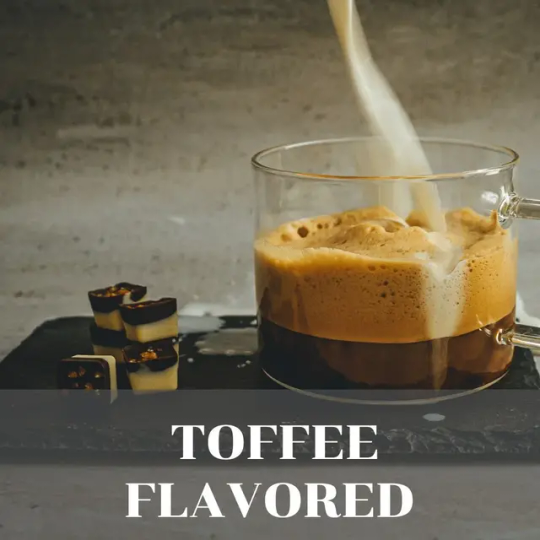
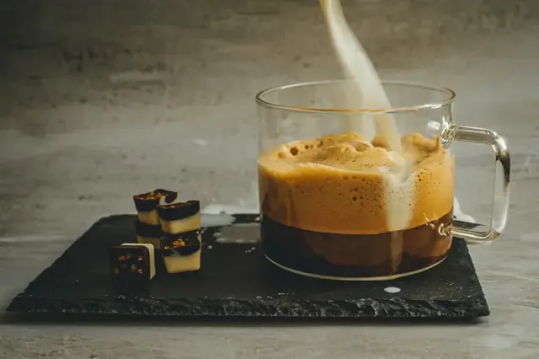
Toffee Flavored Coffee Servings: 6 Ingredients For Toffee Flavored Coffee 1/2 cup heavy whipping cream 1 tablespoon confectioners' sugar 1/2 cup milk chocolate toffee bits 5 cups hot brewed coffee 2 tablespoons butterscotch ice Cream topping Directions To Make Toffee Flavored Coffee In a small mixing bowl, beat cream until it begins to thicken. Add confectioners' sugar; beat until stiff peaks form. Stir toffee bits into coffee; let stand for 30 seconds. Strain and discard any undissolved toffee bits. Pour coffee into 6 mugs. Top with whipped cream and drizzle with butterscotch topping. What is the difference between caramel and toffee? The difference between toffee and caramel is that caramel is made with white granulated sugar and cooked to 340 degrees Fahrenheit, whereas toffee is made with butter and brown sugar and cooked to 295 - 309 degrees Fahrenheit. Email Twitter Pinterest Facebook LinkedIn Reddit Keep In Touch If You Like My Articles. As much as I like to share my knowledge and skills with you, I love to hear from you. If you have any suggestions or comments, please click here. Also don't forget to subscribe to our quarterly newsletters if you like my blogs and like to keep in touch. Of course, read more blog posts I post now and then, such as "How To Make Coffee Less Acidic". Read the full article
0 notes
Text
Cold Brew At Home: My #1 Quest For An Extreme Easy Kitchen Counter Concoction


Cold Brew At Home Made Easy My Make Shift Cold Brew At Home The allure of cold brew coffee had been brewing in my mind for a while. The promise of smooth, refreshing coffee, perfect for hot summer days or any other day, was too tempting to ignore. However, the fancy or expensive equipment and precise ratios I found online seemed daunting. Determined to avoid buying any fancy or expensive equipment online or at any store, and fueled by a thirst for cold brew, I embarked on a journey of experimentation with the tools I had readily available: a trusty stainless steel mug and a handheld sieve.Here is the record of my cold brew at home journey:

My Mug Is Almost Identical To This One My brewing vessel, a 3-cup stainless steel mug, might not have been the most conventional or beautiful choice, but it held the promise of a single-serving batch, perfect for a solo cold brew adventure. With 2.5 cups of water filling the mug to just below the rim, I embarked on the quest for the perfect coffee grounds. After some deliberation, I opted for 5 tablespoons of Liberica coffee, a bold bean known for its low acidity. Grinding the beans wasn't an option, so I relied on pre-ground coffee, hoping for the best.

My Sieve Was Originally a Oil Filter Eighteen hours later, the moment of truth arrived. Armed with my trusty handheld stainless steel fine mash sieve, I approached the mug with a touch of trepidation. Would my unorthodox approach yield a drinkable result? The first hurdle was successfully navigating the grounds through the sieve. The fine mesh did a surprisingly good job, capturing the spent coffee while allowing the precious cold brew to flow through.The result of my cold brew at home:The resulting brew was a revelation. The first sip brought a wave of smooth, refreshing coffee. The absence of bitterness or sourness was a testament to the cold brewing process and the low acidity of the Liberica beans. While the aroma wasn't as intense as a freshly brewed hot cup, the taste more than compensated. It was a subtle symphony of coffee notes, perfectly complimented by the natural sweetness of the cold brew. I did mix it with a splash of fresh heavy cream though, that added another layer of smoothness to the taste.Heaven!!! Daily Routine Now: Cold Brew At Home This kitchen counter cold brew became my daily companion. Each morning, the simple act of combining water and grounds in the mug, followed by the overnight wait, culminated in a delightful pick-me-up. It was a testament to the fact that delicious cold brew doesn't require fancy equipment or precise measurements. Sometimes, all you need is a little ingenuity and a thirst for experimentation. Who knows, maybe your next culinary adventure awaits within the confines of your kitchen, waiting to be brewed with a little creativity. The only drawback to my perfect cup of cold brew at home? It's simply too delicious. Unlike some store-bought cold brews, this one is dangerously drinkable, easy, and simple to make. I can easily polish off 4 or more cups in a day, which, let's be honest, is probably a recipe for caffeine overload. Unfortunately, I was caught up in the daily grind and didn't manage to capture the process with photos. However, I'm planning to document my next cold brew session visually so you can see this mug-brewing method in action! Email Twitter Pinterest Facebook LinkedIn Reddit Keep In Touch If You Like My Articles. As much as I like to share my knowledge and skills with you, I love to hear from you. If you have any suggestions or comments, please click here. Also don't forget to subscribe to our quarterly newsletters if you like my blogs and like to keep in touch. Of course, read more blog posts I post now and then, such as "Cold Brew Kits". Read the full article
0 notes
Text
Kahlua Coffee Recipe, Serve 1: A Very Simple Recipe


Kahlua Coffee Servings: 1 Ingredients 2 fluid ounces Kahlua 3 fluid ounces coffee Or 2 espresso shots if a strong coffee taste is preferred. Directions Add Kahlua to coffee. Garnish with orange peel or a cinnamon stick. Does Kahlua Coffee Have Alcohol? Originating in Mexico in 1936, Kahlúa is a rum and coffee liqueur loved worldwide. Used in various drinks—from coffees to cocktails—it goes hand in hand with many occasions. Classic cocktails, like the White Russian, Espresso Martini, and Black Russian wouldn't be the same without it. Email Twitter Pinterest Facebook LinkedIn Reddit Keep In Touch If You Like My Articles. As much as I like to share my knowledge and skills with you, I love to hear from you. If you have any suggestions or comments, please click here. Also don't forget to subscribe to our quarterly newsletters if you like my blogs and like to keep in touch. Of course, read more blog posts I post now and then, such as "Is Coffee Bad For Dogs?". Read the full article
0 notes
Text
Kahlua Coffee Recipe, Serve 1: A Very Simple Recipe
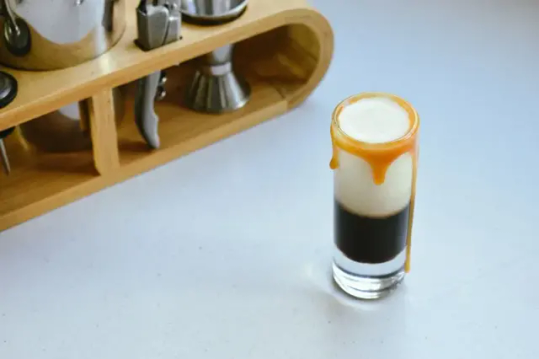
Kahlua Coffee Servings: 1 Ingredients 2 fluid ounces Kahlua 3 fluid ounces coffee Or 2 espresso shots if a strong coffee taste is preferred. Directions Add Kahlua to coffee. Garnish with orange peel or a cinnamon stick. Does Kahlua Coffee Have Alcohol? Originating in Mexico in 1936, Kahlúa is a rum and coffee liqueur loved worldwide. Used in various drinks—from coffees to cocktails—it goes hand in hand with many occasions. Classic cocktails, like the White Russian, Espresso Martini, and Black Russian wouldn't be the same without it. Email Twitter Pinterest Facebook LinkedIn Reddit Keep In Touch If You Like My Articles. As much as I like to share my knowledge and skills with you, I love to hear from you. If you have any suggestions or comments, please click here. Also don't forget to subscribe to our quarterly newsletters if you like my blogs and like to keep in touch. Of course, read more blog posts I post now and then, such as "Is Coffee Bad For Dogs?". Read the full article
0 notes
Text
Is Coffee Bad for Dogs? Heartfelt Concern to Keep Your Pup Safe


Is Coffee Bad For Dogs? Imagine this: Sniffing the air, your playful pup trots into the kitchen, lured by the intoxicating aroma of your freshly brewed coffee. As your furry friend eagerly wags his tail, curious eyes staring at you, a question arises: Is coffee bad for dogs?What started as a morning pick-me-up for you might turn into a trip to the vet for your loyal furry friend. So, let us dig into the truth about coffee and dogs: is it a harmless indulgence or a recipe for disaster? The Percolating Problem: Is Coffee Bad For Dogs? The answer to the question, “Is coffee bad for dogs?” is YES! Coffee contains caffeine, a stimulant that humans readily metabolize. Unfortunately, for our canine companions, it's a different story. Dogs are far more sensitive to caffeine; even small amounts can trigger unwanted effects. According to the American Society for the Prevention of Cruelty to Animals (ASPCA), ingestion of caffeine can lead to increased heart rate, restlessness, tremors, and even toxicity in dogs. Think of it like giving a tiny puppy a double espresso – not exactly a recipe for a relaxing afternoon!A 2018 study published in the Journal of Veterinary Emergency and Critical Care found that a dose of just 2 mg of caffeine per pound of body weight can cause mild signs of toxicity in dogs. According to the study, the lethal dose of caffeine in dogs can vary widely, ranging from 9 to 103 milligrams per pound of body weight. This wide range highlights the importance of knowing your dog's size and weight when evaluating the potential risks associated with coffee consumption.Furthermore, the Pet Poison Helpline reports, that in 2022 alone, there were over 6,000 cases of caffeine toxicity in pets, with coffee being a common culprit. These statistics underscore the need for dog owners to exercise caution and awareness regarding their pets' proximity to coffee and other caffeinated products.The average cup of coffee packs around 95mg of caffeine. So, according to the study, an 11-pound dog would only need to ingest half a cup, about 20 mg of caffeine, to experience mild toxicity. Even a small spill or a discarded coffee pod could put your pup in danger. Coffee grounds are even more concentrated, containing up to 350mg of caffeine per 100g! Just a teaspoon of the coffee grounds can be harmful to a small dog. But beyond the numbers, there's the issue of symptoms. Caffeine poisoning in dogs can manifest in various ways, including: Vomiting and diarrhea Hyperactivity and restlessness Tremors and muscle twitching Rapid heart rate and panting Seizures in severe cases If you suspect your dog has ingested coffee, don't wait! Contact your veterinarian immediately or call the Pet Poison Helpline (1-855-764-7661) for prompt guidance. Unveiling the Unseen Dangers: While caffeine is a well-known concern for dogs, there's another sneaky culprit in that innocent-looking cup of coffee – xanthine compounds. These compounds, such as theobromine and theophylline, are also found in chocolate and can have adverse effects on our canine companions. Ingesting coffee grounds or beans containing these compounds can lead to vomiting, diarrhea, and, in severe cases, life-threatening conditions. While sharing your morning coffee might seem harmless, the potential consequences are far too serious to risk. A Plea for Pawsibility: What shall we do to enjoy a morning bonding session with Fido? There are plenty of ways to include your furry friend in your coffee ritual without putting them at risk. Here are some paw-sitive alternatives: Skip the caffeine: Opt for decaf coffee or herbal teas – perfect for a cozy cuddle on the couch with your pup. Offer dog-friendly treats: Spoil your pooch with specially formulated "puppuccinos" made with whipped cream or carob instead of coffee. Engage in playtime: Instead of sharing your coffee, get your pup moving with a fun game of fetch or a walk in the park. As responsible dog owners, it's crucial to be vigilant and proactive in safeguarding our pets from potential harm. While the allure of sharing a cozy coffee moment with our furry friends is understandable, it's essential to resist the temptation. Opt for dog-friendly treats or spend quality time engaging in activities that bring joy to both you and your pet. Conclusion: Is coffee bad for dogs? The data suggests a resounding "yes." As we sip our morning brew, let's not forget that our four-legged friends rely on us to keep them safe. I leave you with these questions: how do you navigate your morning routine with a canine companion by your side? Are there alternatives you've discovered that bring equal joy to both you and your furry friend? Share your thoughts and experiences in the comment section below, for in this collective wisdom lies the key to a truly pawsome relationship. Sources: Journal of Veterinary Pharmacology and Therapeutics Pet Poison Helpline American Society for the Prevention of Cruelty to Animals (ASPCA) American Kennel Club Email Twitter Pinterest Facebook LinkedIn Reddit Keep In Touch If You Like My Articles. As much as I like to share my knowledge and skills with you, I love to hear from you. If you have any suggestions or comments, please click here. Also don't forget to subscribe to our quarterly newsletters if you like my blogs and like to keep in touch. Of course, read more blog posts I post now and then, such as "Best Decaf K Cups". Read the full article
0 notes
Text
How To Make Coffee Less Acidic: The Quest for a Calmer Cup In 5 Easy Ways


How to make coffee less acidic? Imagine this: you wake up, excited for a steaming cup of coffee to kickstart your day. But as you take that first sip, a familiar zing hits your tongue – the dreaded coffee acidity. It leaves you wincing, wishing for a smoother, gentler experience. So, how to make coffee less acidic? My research says there is a hidden path to a less acidic cup, which unlocks a world of flavor without the unwanted sourness. Let's explore the secrets to brewing a cup that's as kind to your stomach as it is delicious. Acid's Bitter Bite: Understanding the Coffee Coffee's acidity isn't a villain. It's a natural part of the bean, contributing to its complex flavor profile. Sometimes, those bright, citrusy notes can become overwhelming, leading to heartburn, indigestion, and that unpleasant sour aftertaste. Studies show that around 20% of coffee drinkers experience these issues, so you're not alone! I too don't like sour coffee, no matter how expensive or cheap the coffee costs. The Science Behind the Solutions Here are some key facts and data-driven solutions to help you brew a less acidic cup: 1. Roast Revelation: The Power of Darkness Did you know that darker roasts are your acidity-busting allies? Lighter roasts retain more of the bean's natural acids, while darker roasts undergo a longer roasting process that breaks down these acids, resulting in a smoother, less acidic brew. According to the National Coffee Association, light roasts typically have a pH ranging from 4.5 to 6, while dark roasts hover around 6 to 7. So, next time you're at the coffee shop, opt for a French roast or an espresso blend for a gentler experience.Data point:A study by the National Coffee Association found that 62% of Americans prefer dark roast coffee. 2. Brewing Buddies: Time and Temperature Water temperature and brewing time play a crucial role in acidity. Overheating or over-extracting your coffee can amplify its acidity. For a less acidic cup, try: Cold brew: This method uses cold water and a long brewing time (12-24 hours), resulting in a smooth, naturally less acidic coffee. Medium grind and shorter brewing time: For a less acidic potion, opt for a coarser grind. A coarser grind size makes the brewing a slower extraction process, yielding a cup of coffee with reduced acidity. Use a medium grind and aim for a brewing time of 2-3 minutes. This prevents over-extraction and keeps the acidity in check. Data point: A study published in the Journal of Agricultural and Food Chemistry found that cold-brew coffee had a 67% lower acidity level than hot-brewed coffee. 3. Beyond the Bean: Milk's Magic Touch Milk isn't just a creamy addition, it's an acidity neutralizer! Milk's proteins and calcium carbonate act as buffers, reducing the perceived acidity of your coffee. Plant-based milks like almond or soy milk can also work, offering a dairy-free option. So, whether you prefer a latte, cappuccino, or a simple splash of cream, let the milk magic unfold as you craft your ideal cup of morning bliss.Data point:A study published in Food Chemistry found that adding milk to coffee increased its pH level (making it less acidic) by 0.5 units. 4. Unconventional Heroes: Eggshells and Baking Soda Looking for a unique twist? Try adding eggshells or baking soda to your coffee. Eggshells are naturally alkaline and can neutralize acidity, while baking soda (in small amounts) can have a similar effect. Remember, moderation is key to avoid altering the taste significantly.Caution:Consult your doctor before trying baking soda if you have any health concerns. 5. Freshness is Key: Store Like a Pro Stale coffee beans are more acidic than fresh ones. Store your beans in an airtight container away from light and heat to preserve their flavor and minimize acidity. Beyond the Recipe: Your Coffee Journey Awaits Remember, brewing the perfect cup is a personal journey. Experiment with different roasts, brewing methods, and additives to find what works best for your taste buds and stomach. Don't be afraid to get creative and explore the endless possibilities the coffee world offers. Dear readers, please share your brewing adventures in the comments below. What alchemical methods have you employed to make your coffee less acidic? Are you a fan of the dark roast enchantment, or do you prefer the milk and coffee in your cup? Your insights may be the key to unlocking new dimensions of flavor for our fellow homebrewers. So, let the conversation begin – what's your secret to a harmonious cup of coffee? Let's continue this quest for delicious and gentle coffee together. Email Twitter Pinterest Facebook LinkedIn Reddit Keep In Touch If You Like My Articles. As much as I like to share my knowledge and skills with you, I love to hear from you. If you have any suggestions or comments, please click here. Also don't forget to subscribe to our quarterly newsletters if you like my blogs and like to keep in touch. Of course, read more blog posts I post now and then, such as "Best Low Acid Coffee K Cups". Read the full article
0 notes
Text
5 Best Coffee Makers Under 200 USD: A Guide for the Coffee Nerd


Which Coffee Maker is the Best Coffee Maker Under $200? If you're a coffee lover, you know that a good cup of coffee can make all the difference in your day. But with so many coffee makers on the market, it can be hard to know which one to choose. That's why I've put together a list of the top coffee makers under 200 USD. Whether you're looking for a quick and easy cup of coffee or you're a coffee enthusiast who carefully chooses and grinds your beans every morning, I've got you covered. So let's take a look at these best coffee makers under 200 USD!
#1

OXO Brew 8-Cup Coffee Maker The best $200 coffee maker It makes coffee as good as the coffee shop. $178 from Amazon What did happen to the original price listed here?The unit price dropped from around $200 to almost $178 now, so I update this info accordingly.OXO Brew 8-Cup Pros & Cons SummaryPros:Quality Brewing: Produces consistently delicious coffee thanks to its even showerhead design and optimal brewing temperature. Users report a clean, flavorful cup. Simple and User-Friendly: Features a straightforward design with clear controls and intuitive operation. No complicated settings to fuss with. Built-in Grinder Option: The OXO Brew has a compatible burr grinder attachment (sold separately) for those who prioritize fresh-ground coffee and maximum flavor. Limited Capacity: The 8-cup carafe might not be enough for larger households or those who drink a lot of coffee throughout the day. No Automatic Milk Frother: Doesn't have a built-in milk frother, so creating milky coffee drinks requires a separate appliance. Price: While not the most expensive coffee maker on the market, it might be pricier than some basic drip machines, especially considering a separate grinder might be needed for fresh-ground coffee.This coffee maker is my top pick. It's easy to use, and it consistently makes good coffee. The parts are all BPA-Free. It has a thermal carafe that keeps your coffee hot for up to 4+ hours. It takes up little counter space and has an automatic clean cycle and an indicator light that comes on after 90 cycles. It doesn’t leak and is easy to clean. It is pretty in design. If you are going to make high-quality coffee, this is the high-quality coffee maker you need at a very reasonably affordable price.
#2

Ninja CP307 Brewed System The 2nd run-up $200 coffee maker Its versatility makes it a valuable coffee maker for a wide range of applications and situations. Not only does it brew good hot coffee or tea, but it also brews iced coffee and tea. $150 from Amazon What did happen to the original price listed here?The unit price dropped from around $200 to almost $150 now, so I update this info accordingly.Ninja CP307 Pros & Cons SummaryPros:Versatility: Brews a variety of coffee styles (hot or cold brew) and sizes (single cup to full carafe) along with dedicated tea settings. Multiple Brewing Functions: Features separate brewing options for hot coffee, cold brew, and tea, allowing you to customize your beverage preference. Temperature Control: Some users report the coffee brewing a bit hotter than ideal, potentially leading to bitterness. The cold brew function might not be as strong as dedicated cold brew makers. Limited Customization: While offering brew size and style options, it lacks the level of control over coffee strength or water temperature found in high-end drip coffee makers. Bulkier Design: Compared to some coffee makers, the Ninja CP307 can take up more counter space due to its multi-functionality.This coffee maker is a great choice for people who want versatility. It can make a variety of coffee drinks, including regular coffee, single-serve coffee, and specialty coffee drinks like lattes and cappuccinos. There are multiple options to make adjustments to your brewer: the warming plate can be set to off, or adjust your time up to 4 hours with auto shut off at the end. It also has a built-in frother, so you can make your own foamed milk at home, and it is easy to clean. Ninja CP307 has a thermal carafe that keeps your coffee hot for up to 2 hours. Ninja CP307 makes great iced and hot coffee and tea with a multitude of sizing options. If you like a variety of coffees and teas and appreciate the ability to enjoy a good specialty drink at home, this should be a good option for you.
#3

Keurig K-Supreme Coffee Maker The 3rd run-up $200 coffee maker It is simple to use. It comes with multi-stream technology and user-customizable settings, such as strength, temp, and cup size. $135 from Amazon What did happen to the original price listed here?The unit price dropped from around $200 to almost $135 now, so I update this info accordingly.Keurig K-Supreme Pros & Cons SummaryPros:Variety and Convenience: Uses K-Cups, offering a vast selection of coffee flavors, tea blends, and even hot chocolate from various brands. Just pop in a K-Cup and brew for a quick and easy cup. Multiple Brew Sizes: Allows brewing different cup sizes (typically 6, 8, 10, and 12 ounces) to suit your needs, whether you want a quick pick-me-up or a larger travel mug. Customization Options: Features like adjustable strength control and the ability to brew over ice for iced coffee cater to some preferences for stronger coffee or cold beverages. Cost per Cup: K-Cups can be more expensive than using ground coffee, especially for frequent coffee drinkers. Limited Control: Offers less control over coffee flavor compared to manual brewing methods like pour-over or French press. You're limited to the pre-measured coffee and flavors within the K-Cups. Environmental Impact: K-Cups are generally not recyclable and create plastic waste, a concern for eco-conscious consumers.It is equally as good as the Ninja CP307. Keurig K-Supreme coffee maker is a popular choice for people who like the convenience of single-serve coffee. It has a variety of features, including a strength selector, and a hot water spout. The 78-ounce removable water reservoir can brew to fill five different cup sizes. Its button controls are intuitive and allow you to program it to have your morning coffee waiting for you. The K-Supreme will accommodate over 400 varieties of pods, including a refillable one for your grounds, thus ensuring that everyone will be happy with their hot beverage. If you like a variety of coffees and teas and appreciate the ability to enjoy a good specialty drink at home, this could be a good option for you.
#4
Read the full article
#Coffee#coffeedreamland#coffeemachines#coffeemakerunder$200#coffeemakers#coffeemakersunder$200#koffeetips
0 notes
Text
The Heartbeat of Your Morning Brew: How Coffee Affects Heart Rate?

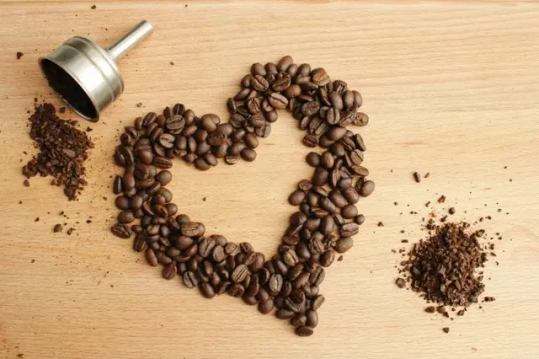
How Coffee Affects Heart Rate? Imagine you're in a quiet cafe, the aroma of freshly brewed coffee filling the air. You take a sip, the warmth spreading through your chest, and suddenly, your heart pounds. Is it the caffeine giving you a jolt, or is it just your imagination?In this blog post, I will share the intriguing world of coffee and how coffee affects heart rate. Let's explore the science behind that familiar thump-thump in our chests and discover the secrets hidden within our favorite morning drink. The Science Behind How Coffee Affects Heart Rate Coffee's heart-pumping secret lies in its main ingredient: caffeine. This stimulant blocks adenosine, a chemical in your brain that promotes sleep and relaxation. With adenosine out of the way, your nervous system kicks into high gear, releasing hormones like adrenaline and noradrenaline. These hormones, in turn, increase your heart rate and blood pressure, making you feel more alert and energized.According to a study published in the Journal of the American College of Cardiology, caffeine can temporarily increase heart rate and blood pressure. The researchers found that within 45 minutes of consuming caffeine, participants experienced a noticeable spike in both metrics. The average increase in heart rate ranged from 5 to 15 beats per minute, a surge that could be attributed to caffeine's stimulating effect on the nervous system.In a comprehensive meta-analysis of 17 studies conducted by the American Heart Association, researchers discovered a consistent trend. On average, participants who consumed caffeine experienced a modest but measurable increase in heart rate compared to the control group who didn’t drink coffee.Furthermore, a study published in the International Journal of Cardiology took a closer look at the relationship between coffee consumption and heart rate variability (HRV)—a measure of the variation in time between heartbeats. The findings suggested that moderate coffee intake might have a positive effect on HRV, indicating a potential benefit for cardiovascular health. How Much is Too Much? While these studies shed light on the immediate effects of caffeine on heart rate, it's essential to recognize that moderation is key. Too much caffeine can lead to adverse effects, including palpitations and increased anxiety. The big question is, how much coffee is too much for your heart? It depends!For most healthy adults, moderate coffee consumption, up to 400mg of caffeine per day, roughly 4 cups of brewed coffee, is generally considered safe. This amount is unlikely to cause significant changes in heart rate or blood pressure. However, if you're sensitive to caffeine, even small amounts can trigger jitters, heart palpitations, and anxiety. You might also experience insomnia, headaches, and even digestive issues. People with certain health conditions, such as heart disease, high blood pressure, or anxiety disorders, should be extra cautious with caffeine. It's best to talk to your doctor about how much coffee is safe for you. Beyond the Individual: Stats and Data Now, let's get nerdy with some stats and data:A study published in the journal Circulation found that drinking two cups of coffee daily was associated with a small but significant increase in heart rate, around 3 beats per minute. However, this increase was short-lived and didn't seem to have any negative health effects. Another study, published in the journal Nutrition, found that people who drank four or more cups of coffee per day had a higher risk of developing atrial fibrillation, a type of irregular heartbeat. However, it's important to note that this study was observational, meaning it couldn't prove that coffee caused atrial fibrillation. Finally, a large review of studies published in the journal The Lancet found that moderate coffee consumption was associated with a decreased risk of heart disease and stroke. This suggests that, for most people, the benefits of coffee outweigh the risks. The Bottom Line: Listen to Your Body So, does coffee make your heart race? It can, but the effects vary depending on the individual and how much you consume. The key is to listen to your body. If you experience any negative side effects after drinking coffee, cut back or quit altogether. And remember, moderation is key! As home coffee brewers, you have the power to personalize your coffee experience and potentially minimize its impact on your heart rate. Here are some tips: Choose lower-caffeine beans. Robusta beans have about twice the caffeine content of Arabica beans. Opt for Arabica or a blend with a lower caffeine content. Go for lighter roasts. Lighter roasts tend to have slightly less caffeine than darker roasts. Skip the sugary extras. Added sugars and cream can increase your heart rate and blood pressure. Stick to black coffee or use natural sweeteners like honey, or stevia. Pay attention to how you feel. If you notice your heart racing after drinking coffee, try brewing a weaker cup, reducing your intake, or switching to decaf. Remember, coffee is a complex beverage with a range of effects on the body. By understanding how it works and listening to your individual needs, you can enjoy your cup of joe guilt-free and keep your heart happy. Here are a few questions I have for you: How has your heart rate journeyed alongside your coffee-drinking habits, and what steps do you take to ensure a harmonious relationship between your morning brew and your heart's rhythm? Do you have any questions or tips about coffee and heart health? Share them in the comments below! Email Twitter Pinterest Facebook LinkedIn Reddit Keep In Touch If You Like My Articles. As much as I like to share my knowledge and skills with you, I love to hear from you. If you have any suggestions or comments, please click here. Also don't forget to subscribe to our quarterly newsletters if you like my blogs and like to keep in touch. Of course, read more blog posts I post now and then, such as "Top 5 Coffee Beans In The World". Read the full article
0 notes
Text
The Curious Case: Is Your Morning Cup Of Coffee Bad For Cats?


Is Coffee Bad For Cats? A curious cat named Whiskers lived in a quaint neighborhood, where sunlight kissed the windows and the aroma of freshly brewed coffee danced through the air. Whiskers was known for his playful antics and a keen interest in everything that unfolded in the cozy kitchen. One day, as the irresistible scent of coffee beans filled your kitchen, YOU pondered a question many cat owners have asked: Is coffee bad for cats? Join me on a journey through the danger of caffeine and whiskers as I find the answer to the tale of feline safety. The Caffeinated Culprit: Coffee Bad For Cats Coffee, a morning magic for many, contains caffeine, a stimulant that gives humans a wake-up jolt. However, for our feline friends like Whiskers, it can spell trouble. According to the American Society for the Prevention of Cruelty to Animals (ASPCA), caffeine is a known toxic substance for cats. Ingesting even small amounts can lead to a range of adverse effects, from restlessness and increased heart rate to more severe complications, such as seizures or even death.The simple answer to this question is coffee bad for cats, is YES! COFFEE IS BAD FOR CATS! The Science Behind the Sniff: Coffee Bad For Cats Let's delve into the science behind this feline mess-up. A 2017 study published in the Journal of Veterinary Pharmacology and Therapeutics found that a dose of just 1mg of caffeine per pound of body weight can cause mild signs of toxicity in cats. A single lap of strong coffee could be enough to send your kitty on a jittery rampage. The risk is lower for larger breeds, but it's still important to be cautious. The average cup of coffee packs around 95mg of caffeine. So, according to the study, a 10-pound cat would only need to ingest one-fifth of a cup, about 20 mg of caffeine, to experience mild toxicity. Even a small spill or a discarded coffee pod could put your feline friend in danger. Remember, coffee grounds are even more concentrated, containing up to 350mg of caffeine per 100g! Just a teaspoon of the coffee grounds could be harmful to a small cat. Symptoms to Watch Out For: But beyond the numbers, there's the issue of symptoms. Caffeine poisoning in cats can manifest in various ways, including:Vomiting and diarrhea Hyperactivity and restlessness Tremors and muscle twitching Rapid heart rate and panting Seizures in severe casesIf you suspect your cat has ingested coffee, don't wait! Contact your veterinarian immediately or call the Pet Poison Helpline (1-888-426-4435) for prompt guidance. Furthermore, data from the Pet Poison Helpline revealed a concerning rise in caffeine-related incidents involving cats. Every year there are about 4,000 reported cases of feline exposure to caffeine in the US, with coffee being a common source. These numbers emphasize the need for cat owners to be vigilant and proactive in ensuring their pets are shielded from potential harm from caffeine. The Hidden Hazards: Coffee Bad For Cats While caffeine is the primary concern, there are hidden hazards in that innocent cup of coffee – theobromine and theophylline. These xanthine compounds also found in chocolate, can wreak havoc on a cat. Ingesting coffee grounds or beans containing these compounds may lead to symptoms such as vomiting, diarrhea, and, in severe cases, can result in life-threatening conditions. This emphasizes the importance of keeping coffee and other caffeinated products out of reach of our feline companions. A Plea for Purr-tection: Responsible cat owners must ensure our feline friends are safe and sound. While the temptation to share a moment with Whiskers over a cup of coffee is understandable, it's crucial to resist. Opt for cat-friendly treats or engage in playtime to strengthen your bond without putting your furry friend at risk. So, back to our curious cat. While sharing your morning coffee might seem like a harmless bonding experience, the potential consequences are far too serious to risk. Repeat this: Coffee Is Bad For Cats! After all, your cat's health and well-being are way more important than that extra morning jolt for them which they don’t need in the first place. What shall we do, coffee-loving cat owners? There are plenty of ways to include your furry friend in your coffee ritual without putting them at risk. Here are some paw-sitive alternatives: Skip the caffeine: Opt for decaf coffee or herbal teas – perfect for a cozy cuddle on the couch with your feline friend. Offer cat-friendly treats: Spoil your kitty with specially formulated "cat-puccinos" made with whipped cream or carob instead of coffee. Engage in playtime: Instead of sharing your coffee, get your cat moving with a fun game of wand toys or a laser pointer. Remember, your love for your cat extends beyond just sharing your treats. By understanding the potential dangers of coffee and making responsible choices, you can ensure your furry friend stays safe and enjoys many more happy mornings by your side. Conclusion: Coffee Bad For Cats In our daily lives, where the comforting aroma of coffee intertwines with shared moments, the question echoes: Is coffee bad for cats? The evidence suggests a resounding "YES." As we navigate our morning routines, let's remember that our whiskered companions trust us to keep them safe. The statistics speak volumes about the prevalence of caffeine-related incidents, urging us to be more cautious. So, dear readers, how do you balance your love for coffee with the safety of your feline friends? Are there alternative morning rituals that bring joy to both you and your cat? Share your thoughts and experiences in the comment section below, for in this shared wisdom lies the key to a purr-fectly harmonious relationship. Sources: Journal of Veterinary Pharmacology and Therapeutics Pet Poison Helpline American Society for the Prevention of Cruelty to Animals (ASPCA) Email Twitter Pinterest Facebook LinkedIn Reddit Keep In Touch If You Like My Articles. As much as I like to share my knowledge and skills with you, I love to hear from you. If you have any suggestions or comments, please click here. Also don't forget to subscribe to our quarterly newsletters if you like my blogs and like to keep in touch. Of course, read more blog posts I post now and then, such as "5 Best Coffee Grinders For Cold Brew". Read the full article
0 notes
Text
How to Make Nitro Cold Brew at Home - 2 Ways For Every Coffee Aficionado

Caution, Caution, and Caution:Learn how to make nitro cold brew at home can be DANGEROUS!!!

Nitro Cold Brew or Cold Brew? How Nitro Cold Brew Is Made? Nitro cold brew is made through a two-step process: cold brewing the coffee and then infusing it with nitrogen. Here's a breakdown of each step: 1. Cold Brewing: Coarsely ground coffee: The process starts with coarsely ground coffee, similar to the size of coarse sand. Steeping in cold water: The grounds are steeped in cold water (room temperature or slightly cooler) for an extended period, typically 12 to 24 hours. This allows for a smoother and less acidic coffee compared to hot brewing methods. Straining: Once steeped, the coffee is strained to remove the grounds, resulting in a concentrated cold brew. 2. Nitrogen Infusion: Kegs: The cold brew is then transferred to kegs. Chilled and carbonated: These kegs are chilled to maintain the cold temperature. Additionally, they may be slightly carbonated for a subtle fizz, though not to the same extent as regular soda. Nitrogen injection: The key step involves injecting nitrogen gas into the kegs. Nitrogen is insoluble in water, meaning it doesn't readily dissolve like carbon dioxide. This creates tiny nitrogen bubbles throughout the coffee. Creamy texture: These bubbles create a cascading effect when pouring and contribute to the signature smooth and creamy texture of nitro cold brew.Depending on the specific brewing method, some variations might exist, like using a mini-keg and nitrogen canisters for home brewing or infusing the cold brew with nitrogen directly during the brewing process. However, the core principles of cold brewing and nitrogen infusion remain the same. How To Make Nitro Cold Brew At Home? There are two main approaches to making nitro cold brew at home:Using a whipped cream dispenser: This method involves making cold brew concentrate beforehand and then infusing it with nitrogen using a whipped cream dispenser with nitrogen cartridges. Using a mini nitro keg system: This method involves purchasing a mini keg system specifically designed for nitro cold brew. You'll need to fill the keg with cold brew concentrate and then use nitrogen canisters to infuse it with nitrogen. some general steps involved in both methods: Make cold brew concentrate: Steep coarsely ground coffee in cold water for 12-24 hours. Prepare your chosen method:Whipped cream dispenser: Add cold brew concentrate to the dispenser, screw on the dispenser head, and charge it with a nitrogen cartridge. Shake and dispense the infused cold brew. Mini keg system: Follow the specific instructions for your mini keg system to fill it with cold brew concentrate and infuse it with nitrogen using canisters. Important safety considerations: Nitrogen canisters can be dangerous if not handled properly. Always follow the manufacturer's instructions when using them. Homemade methods may not achieve the same level of carbonation or creaminess as professionally made nitro cold brew. Conclusion It's crucial to prioritize safety and conduct thorough research before attempting to make nitro cold brew at home. Consider the potential risks involved and ensure you understand the proper handling of equipment and materials. If you're unsure or uncomfortable with the process, it's always recommended to purchase commercially prepared nitro cold brew or visit a coffee shop that offers it. FAQ About Nitro Cold Brew Is nitrogen safe to drink in coffee? The nitrogen gas used in nitro cold brew is perfectly safe to consume. Unlike the larger, fizzy bubbles found in soda and regular beers due to carbon dioxide, nitrogen creates micro-bubbles that deliver a luxurious, creamy mouthfeel without any added milk, sugar, or sweeteners. I was blown away by the smooth texture and creamy taste of nitro cold brew when I tried it the first time! Is nitro cold brew better than espresso? There is no way to compare these two brewing methods, it all depends on personal preference: one person's palate is different from the others! Espresso is a hot drink with fewer ingredients than nitro cold brew, a simpler process, and a shorter brew time. As a cold drink, nitro cold brew requires more ingredients, a longer process, and more time for brewing. I love and enjoy both brews! Is nitro cold brew stronger than regular cold brew? Yes, there is more caffeine in nitro cold brew vs regular coffee, but the extra caffeine compared to regular coffee is from the cold brew method, not the nitrogen infusion process. What is Special About Nitro Cold Brew? Nitro cold brew is cold brew coffee infused with nitrogen gas. Nitrogen is insoluble in water, meaning it doesn't readily dissolve like carbon dioxide. This creates tiny nitrogen bubbles throughout the coffee and gives nitro cold brew its signature thick, creamy texture. The combination of a creamy texture, subtle sweetness, less bitterness, and the unique cold brewing and nitrogen infusion process makes nitro cold brew a distinctive and enjoyable coffee experience. Give it a try, I can assure you that you will love it once you try it!!! Email Twitter Pinterest Facebook LinkedIn Reddit Keep In Touch If You Like My Articles. As much as I like to share my knowledge and skills with you, I love to hear from you. If you have any suggestions or comments, please click here. Also don't forget to subscribe to our quarterly newsletters if you like my blogs and like to keep in touch. Of course, read more blog posts I post now and then, such as "5 Best Coffee Grinders For Cold Brew". Read the full article
0 notes
Text
Juan’s Iced Coffee Recipe, Serve 2


Juan's Iced Coffee This is my iced coffee recipe, that is why I named it Juan's Iced Coffee. Give it a try and let me know whether you like it. Servings: 2 Ingredients 1 cup freshly brewed coffee 1/2 teaspoon vanilla extract (optional) 2 tablespoons white/brown sugar (or any sweetener you like) 1-ounce boiling water 3/4 cups crushed ice 1 scoop of cream Directions Refrigerate coffee until cool, about 30 - 60 minutes. Chill two glasses, if desired. Stir vanilla extract and sugar in the boiling water until dissolved. Refrigerate until cool, about 30 - 60 minutes. Divide the ice and chilled coffee evenly between the 2 glasses. Stir in cream and sugar mixture to taste. Tips For Juan's Iced Coffee Iced coffee can be made from cold-brew coffee, which may take 12 hours to make. Once it is made, usually the next day, the grounds would be filtered out. Cold brew results in a very strong coffee concentrate which then can be mixed with cream, milk, spices, and sweeteners. When liquids are cold, the channels in your taste buds do not perceive as much flavor; so you may have to add the extra amount of sweeteners in the iced coffee to achieve the same level of sweet taste as if the coffee were at room temperature or warmer (hotter). Email Twitter Pinterest Facebook LinkedIn Reddit Keep In Touch If You Like My Articles. As much as I like to share my knowledge and skills with you, I love to hear from you. If you have any suggestions or comments, please click here. Also don't forget to subscribe to our quarterly newsletters if you like my blogs and like to keep in touch. Of course, read more blog posts I post now and then, such as "Cold Brew Coffee Kits". Read the full article
0 notes
Text
Top 5 Coffee Beans In The World

top 5 coffee Beans in the world
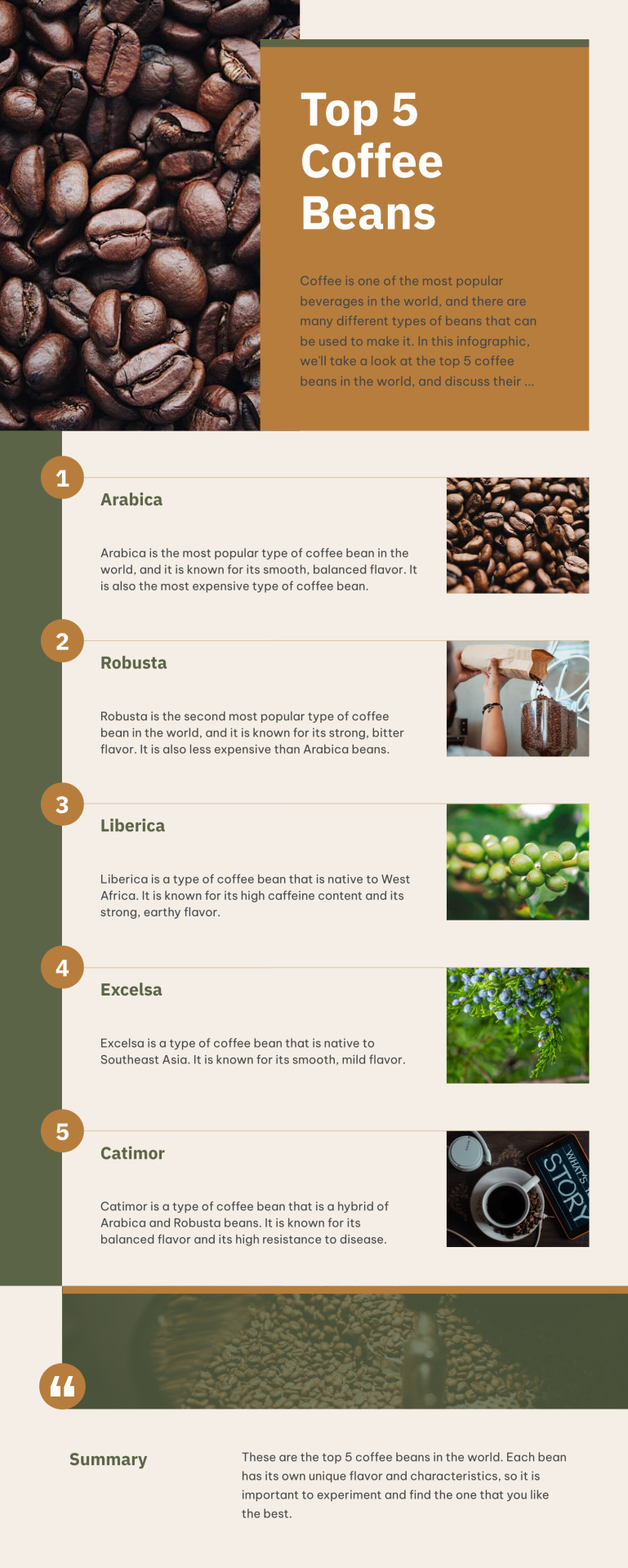
If you like to know more, keep reading: Beyond the familiar duo of Arabica and Robusta, a world of unique coffee adventures awaits. Imagine Liberica, the rare giant boasting smoky-floral notes, or Excelsa, the high-altitude gem with hints of stone fruit. Intrigued? Prepare to delve into lesser-known varieties like the chocolaty Catimor, prized for its balanced sweetness and notes of citrus and spice, and the Blue Mountain from Jamaica with its rich, chocolaty depth. Each origin and bean unveils a distinct journey for your coffee-loving palate. Liberica Often overshadowed by its ubiquitous cousins Arabica and Robusta, Liberica coffee beans offer a truly unique sensory experience. These irregularly shaped giants, nearly twice the size of Arabica beans, boast a captivating aroma redolent of sweet florals and exotic fruits, reminiscent of jackfruit. On the palate, Liberica delivers a bold and complex punch, characterized by smoky, woody notes interwoven with subtle nuttiness. Sadly, this rare gem faces extinction, clinging to survival in Southeast Asia. However, for adventurous coffee connoisseurs seeking to support biodiversity and savor an unparalleled flavor journey, Liberica presents an opportunity not to be missed.

Liberica Beans While Liberica coffee originated in Liberia, currently the Philippines holds the title of the largest producer of Liberica beans. It's known locally as "kapeng barako" and holds cultural significance, particularly in Batangas and Cavite provinces. However, it's primarily consumed domestically.Malaysia ranks second in Liberica production, mainly concentrated in the west coast's "Coffee Belt". Interestingly, their production outpaces Arabica within the country.Although Brazil exports the most Liberica beans, its total production compared to the Philippines and Malaysia remains lower. Additionally, Liberica makes up a small portion of Brazil's overall coffee output. Excelsa What's particularly intriguing about Excelsa is its naturally lower caffeine content, hovering around 40% of what you'd find in a regular cup of Arabica coffee, even less than a Robusta. This makes it a perfect choice for those seeking a smoother, less jittery coffee experience. Plus, its unique flavor profile shines through whether roasted light or dark, offering a versatile pick for adventurous coffee lovers. So, if you're ready to ditch the ordinary and explore the hidden gems of the coffee world, Excelsa awaits!
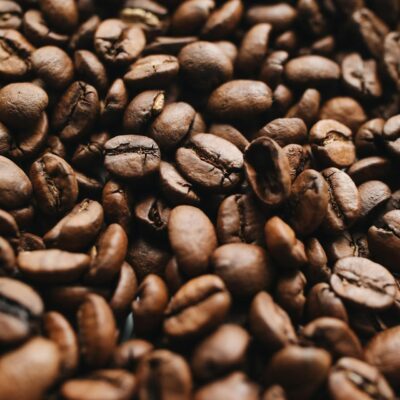
Excelsa Beans Based on available information, the Philippines and Vietnam are the two top producers of Excelsa coffee beans in the world. Excelsa gained popularity among Filipino farmers due to its pest resistance and unique flavor profile. Nevertheless, Excelsa remains a niche coffee globally.Step aside, Arabica, Robusta and Liberica! Excelsa coffee beans offer a flavor adventure unlike any other. These small, round gems, often hailing from Southeast Asia, pack a punch in terms of the taste. Forget your typical coffee profile - Excelsa leans into the unique, boasting vibrant acidity, fruity notes reminiscent of blackcurrant and grapefruit, and even a touch of earthiness that reflects its natural origins. Some describe its aroma as subtly woody, hinting at its complex depth. Catimor Born from a blend of tradition and resilience, Catimor coffee beans are a unique player in the global coffee scene. This hybrid, marrying the disease resistance of Robusta with the aromatic complexity of Arabica, thrives in diverse environments like Vietnam, India, and Indonesia. Known for its compact stature and bountiful yields, Catimor has secured its place as a vital crop for many farmers.

Catimor Beans Flavor-wise, Catimor offers a captivating journey. Expect a balanced and sweet cup, often marked by citrusy notes like orange and lime, mingling with hints of spice like cinnamon and nutmeg. Depending on the origin and roast, chocolatey undertones or a touch of floral aroma might emerge. Whether enjoyed as a bright filter coffee or a rich espresso, Catimor promises a satisfying and distinct experience. So, next time you seek a coffee beyond the ordinary, consider Catimor - a testament to both innovation and the diverse landscape of coffee flavors.With limited data available, Vietnam is widely considered the country that produces the most Catimor coffee beans. Catimor was introduced to Vietnam in the 1980s and quickly gained popularity due to its resistance to leaf rust, a major threat to coffee trees. Due to its high yield and disease resistance, Catimor plays a crucial role in the Vietnamese coffee industry, influencing the overall quality and economic impact of the sector. Countries like India and Indonesia are also cultivating Catimor, contributing to its global availability. Conclusion While Arabica reigns supreme with its smooth complexity and Robusta offers its bold kick, a world of exciting flavors awaits. Liberica, the giant bean, enthralls with smoky-floral notes, while Excelsa, the high-altitude gem, tantalizes with bursts of blackcurrant and grapefruit. Don't miss Catimor, the resilient hybrid, offering a balanced dance of citrus and spice.Each bean, a distinct journey for your palate, whispers tales of unique origins and passionate cultivation. Venture beyond the familiar and embark on a global coffee odyssey. So, ditch the routine, embrace the diversity, and savor the world's top coffee beans – one delicious cup at a time. Email Twitter Pinterest Facebook LinkedIn Reddit Keep In Touch If You Like My Articles. As much as I like to share my knowledge and skills with you, I love to hear from you. If you have any suggestions or comments, please click here. Also don't forget to subscribe to our quarterly newsletters if you like my blogs and like to keep in touch.Of course, read more blog posts I post now and then, such as "Making Coffee Without a Coffee Maker". Read the full article
0 notes
Text
5 Most Popular Coffee Brews In The World

the top 5 most popular coffee Brews in the world
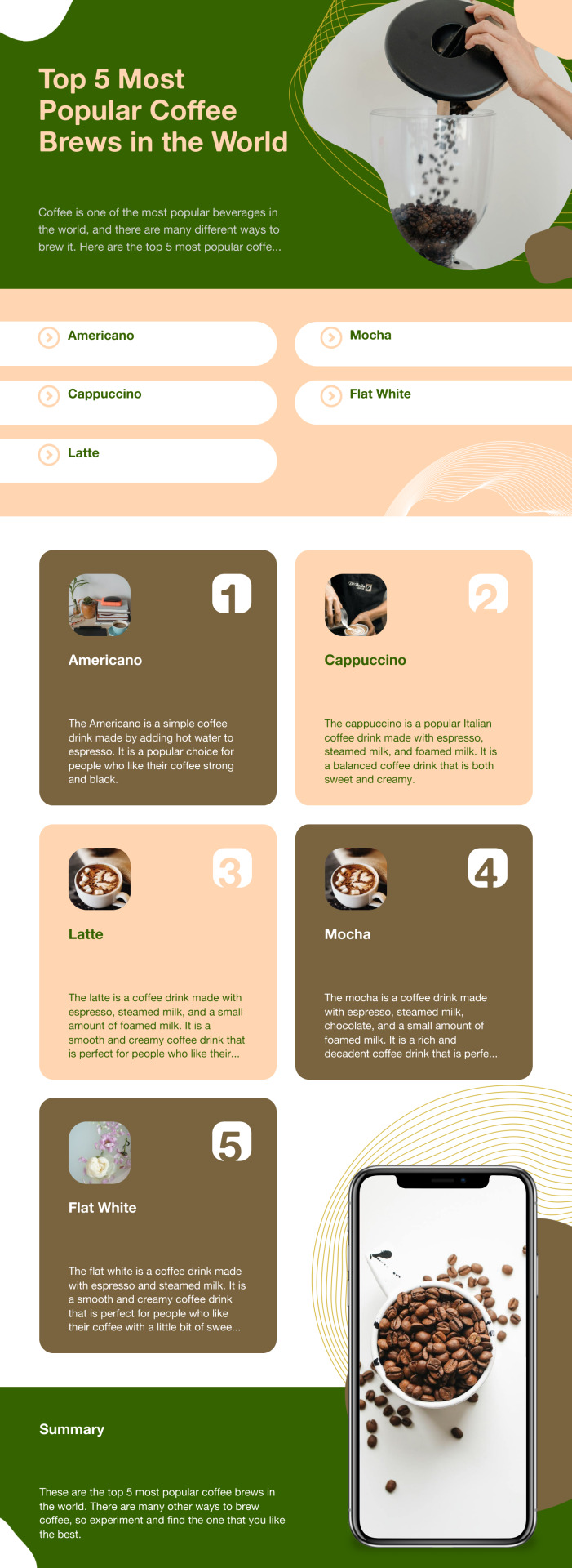
Email Twitter Pinterest Facebook LinkedIn Reddit Keep In Touch If You Like My Articles. As much as I like to share my knowledge and skills with you, I love to hear from you. If you have any suggestions or comments, please click here. Also don't forget to subscribe to our quarterly newsletters if you like my blogs and like to keep in touch.Of course, read more blog posts I post now and then, such as "Arabica vs Robusta". Read the full article
0 notes
Text
The Great Brew-off: Americano vS Coffee


An Americano is a cup of hot water with a shot or two of espresso in it. Americano vS Coffee Once upon a time, in the mystical land of Java, where the aroma of freshly ground beans filled the air, a dilemma puzzled many coffee enthusiasts, just like you and me – the choice between an Americano and a regular cup of coffee. My research story here unfolds as we embark on a journey to discover the secrets behind these two popular brews, examining the nuances that set them apart. The Americano My story begins with the Americano, a mysterious concoction that has captured the hearts of many. The Americano wasn't born in fancy Italian cafes. Contrary to popular belief, it originated in America – yes, you read that right! Soldiers stationed in Italy during World War II craved their familiar drip coffee, so they started diluting espresso with hot water. Voila, the Americano was born!This brew, often called the "watered-down espresso," maintains a distinctive strength while presenting a smoother, more approachable flavor profile. But how does it stack up against its more traditional counterpart – the classic cup of coffee? The Classic Cup of Joe Ah, the classic cup of coffee – a timeless brew that has been the companion of early risers, late workers, and daydreamers alike. Brewed through various methods like drip, pour-over, or French press, the classic coffee boasts a rich, diverse history that dates back centuries. From the Ethiopian highlands to the bustling streets of Vienna, coffee has traversed continents, leaving a trail of aromatic stories in its wake.But what makes a regular cup of coffee different from an Americano? It all comes down to the brewing process. Coffee grounds are steeped in hot water, allowing the flavors to infuse, creating a distinct and familiar taste that varies based on the bean origin and roast level. Here Are Some Interesting Stats 1. Caffeine Showdown: According to a study published in the Journal of Analytical Toxicology, a standard 8-ounce cup of brewed coffee contains approximately 95 milligrams of caffeine. On the other hand, a shot of espresso, the base of an Americano, contains roughly 63 milligrams. When diluted with hot water to create an Americano, the caffeine content remains about 60 - 70 milligrams, offering a balanced kick. 2. Flavor Complexity: The Specialty Coffee Association defines a coffee's flavor profile based on attributes such as acidity, body, and balance. While both Americano and regular coffee can showcase a wide range of flavors, the brewing methods contribute to their unique taste profiles.Americano delivers a concentrated hit of coffee essence, with notes of caramel, chocolate, and even a hint of smokiness. Think of it as the espresso's milder cousin, retaining its punch without the overwhelming bitterness.Drip coffee, with its slower brewing process, extracts a wider range of coffee bean flavors, resulting in a smoother, more balanced cup. Depending on the roast and bean origin, you might experience bright citrus notes, subtle floral hints, or even a chocolatey richness. It's a symphony of flavors, each sip revealing a new nuance. 3. Brewing Time: In the fast-paced world we live in the US, time is often of the essence. A regular cup of coffee, brewed through various methods, usually takes a few minutes to prepare. On the flip side, an Americano, born from the swift extraction of espresso shots, offers a quicker route to that coveted caffeine fix, making it a favorite for those on the go, but only from the cafe or coffee shops. If you make it yourself, the time to prepare the grounds to the end to clean the espresso machine, may not warrant so call “quick fix on the go”. 4. Caffeine Kick: Who Packs the Bigger Punch? Which brew will jolt you awake faster? Surprisingly, the answer is “it depends”.On average, an 8-ounce Americano (with two espresso shots) contains 94-150mg of caffeine, while drip coffee boasts 95-200mg. It seems like drip coffee takes the crown, but remember, these are just averages. The actual caffeine content depends on various factors like bean origin, roast level, and even brewing time.Ultimately, the caffeine champion depends on your brewing habits. If you use a strong espresso blend and two shots, your Americano might pack more punch. But if you brew a full pot of light-roast drip coffee, it could win the caffeine race. The Ultimate Brew-off Question So, who wins the Americano vs coffee showdown? The truth is, “What is your preference?”Are you a fan of intense, bold flavors with a creamy crema? Then the Americano might be your perfect choice.Do you crave a smoother, more nuanced cup with a wider range of flavor notes? Drip coffee might be your mate.The real winner is you, my fellow home coffee lovers. Experiment, explore, and discover which brewing method ignites your taste buds and fuels your day. Remember, the perfect cup is the one that brings a smile to your face and a pep to your step.Now, I throw the question to you, fellow coffee enthusiasts: What's your preferred brewing method? Do you find yourself drawn to the Americano's intensity or the drip coffee's versatility? Share your thoughts and brewing rituals in the comments below! Let's keep the coffee conversation flowing! Sources National Coffee Association USA. (2023, August 8). Coffee brewing methods & ratios chart. National Coffee Association USA. Mayo Clinic. (2022, June 15). Caffeine content for common drinks. Email Twitter Pinterest Facebook LinkedIn Reddit Keep In Touch If You Like My Articles. As much as I like to share my knowledge and skills with you, I love to hear from you. If you have any suggestions or comments, please click here. Also don't forget to subscribe to our quarterly newsletters if you like my blogs and like to keep in touch.Of course, read more blog posts I post now and then, such as "Arabica vs Robusta". Read the full article
1 note
·
View note